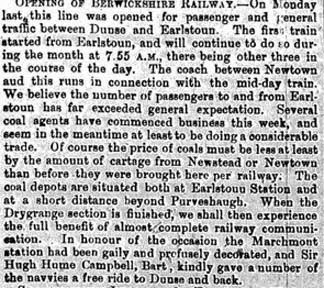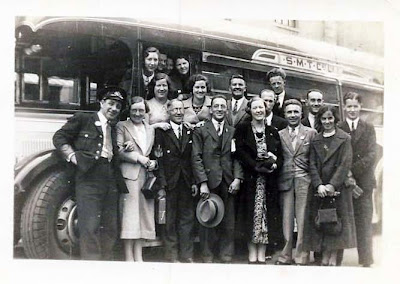The
Berwickshire Railway through Earlston in the Scottish Borders was one of the many lost lines in railway history, serving the village 1863-1965. It provided the link between two major routes - on the
east coast the North British Railway between Edinburgh and London and
in the central Borders the historic Waverley Route between Edinburgh and
Carlisle. The cross country line was built in three stages - to Duns
in 1849, westwards to Earlston in 1863 and the final stage two years
later in 1865 with the completion of the Leaderfoot Viaduct across the
River Tweed.

Earlston Station
"The Kelso Chronicle" of 20th November 1863 reported on the opening at Earlston with an article which made the occasion seem rather prosaic and low key.
In contrast 14 years earlier in 1849, the nearby town of Dunse had welcomed the railway with much celebration. On the opening day the public were carried free of charge, the first train at 2.00 p.m. having no fewer than twenty carriages and it was reported "floral and evergreen arches bestrode the long serpentine row of carriage, a flag waving over the top of the little wooden hut which at present does the duty of a Station House and the Dunse Brass band played". [The Berwickshire Railway - Dunse History Society].
On December 4th 1863, "The Kelso Chronicle" noted "The new railway [at Earlston] is in regular working order and appears to be giving great satisfaction. The trains run smoothly and keep tolerably good time. We are already feeling the benefit of railway communication".
Station
Road, Earlston, leading down to the railway.
Copyright © A R Edwards and Son, Selkirk. (Cathy Chick Collection). All Rights Reserved

Two trains in Earlston station
Copyright © A R Edwards and Son, Selkirk. (Cathy Chick Collection). All Rights Reserved

Two trains in Earlston station
Copyright © A R Edwards and Son, Selkirk. (Cathy Chick Collection). All Rights Reserved
The major engineering feat on the line was the crossing of the River Tweed and the building of the Leaderfoot Viaduct, which involved a nineteen
arch structure 907 feet long and 126 feet above the level of the river bed. Interestingly it is referred to in a newspaper article of December 1864 as the Drygrange viaduct.
The Berwickshire Railway line was never a busy one, with roughly equal traffic of goods and passengers. In Earlston, coal was brought in and stone from the local quarry taken out, with agricultural produce and livestock the mainstays of business.
Leaderfoot Viaduct opened in 1865
The Berwickshire Railway line was never a busy one, with roughly equal traffic of goods and passengers. In Earlston, coal was brought in and stone from the local quarry taken out, with agricultural produce and livestock the mainstays of business.
Two prominent visitors through the station were Prime Minister Asquith in 1908, to make a speech in Earlston, and in 1944 General Eisenhower to inspect the Polish tank regiment stationed in the village. [See earlier posts]

Prime Minister Asquith's party arriving at Earlston Station in 1908

General Eisenhower arriving at Earlston Station to
inspect the
Polish Tank Regiment stationed in the village in 1944.
Devastating floods across Berwickshire in August 1948 meant that passenger services were suspended, due to parts of the trackbed being washed away. Repairs were never fully carried out and only freight services continued on part of the line, which was eventually closed without ceremony on 16th July 1965 - marking the end of the 102 year old line of the Berwickshire Railway through Earlston.
Goods Train at Earlston. March 1965.
Copyright © Bruce McCartney at http://www.geoffspages.co.uk/monorail/bmcc01.htm
All Rights Reserved,
 | ||||||||||||||||
The last train through Earlston Station - July 1965.
On the left is the train's fireman; on the right the couple who worked the level crossing; with their young son in the arms of the stationmaster.
All Rights Reserved,
|
2015 and the site of the old railway line at Earlston
Copyright © N.F.Donaldson. All Rights Reserved.
Gates at the former Level Crossing Cottage.
Copyright © N.F.Donaldson. All Rights Reserved.
Berwickshire Rail Line, east of Earlston -
now part of Gordon Community Woodland
Copyright © N.F.Donaldson. All Rights Reserved.
Do you have memories of Earlston Station? We would love to hear from you - either click on Comment below, or e-mail: auldearlston@aol.com - Thank You.
Gates at the former Level Crossing Cottage.
Copyright © N.F.Donaldson. All Rights Reserved.
Berwickshire Rail Line, east of Earlston -
now part of Gordon Community Woodland
Copyright © N.F.Donaldson. All Rights Reserved.
Postscript: In
1969 amidst the notorious Beeching Cuts, the Scottish Borders lost all
its rail services, making it the only region in mainland Scotland
without a train station. But this all changes in September this year,
when part of the Waverly Line re-opens for 35 miles south of Edinburgh
into the central Borders at Tweedbank
Do you have memories of Earlston Station? We would love to hear from you - either click on Comment below, or e-mail: auldearlston@aol.com - Thank You.
***********
Photographs courtesy of the Auld Earlston Collection,
Cathy Chick, N.F. Donaldson and Bruce McCartney.
Photographs courtesy of the Auld Earlston Collection,
Cathy Chick, N.F. Donaldson and Bruce McCartney.





















